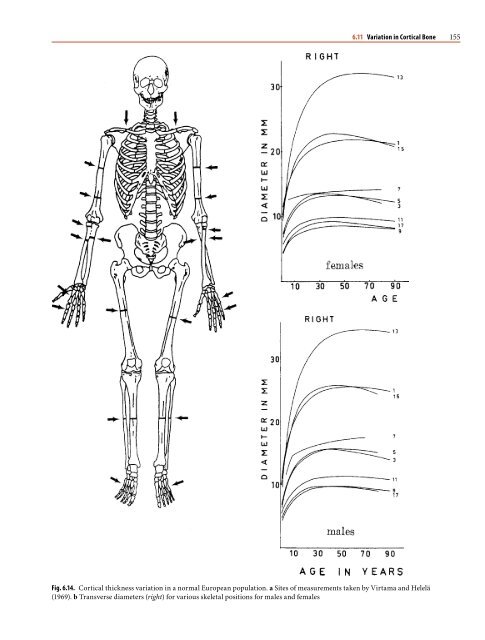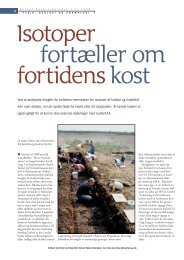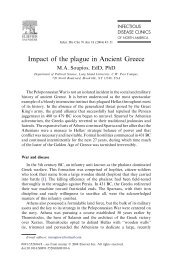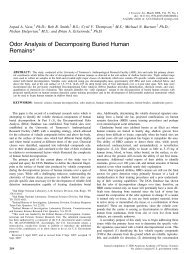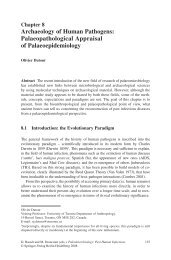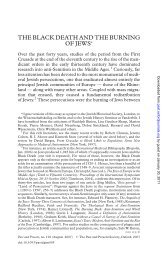1 Paleoradiology: History and New Developments - Academia.dk
1 Paleoradiology: History and New Developments - Academia.dk
1 Paleoradiology: History and New Developments - Academia.dk
Create successful ePaper yourself
Turn your PDF publications into a flip-book with our unique Google optimized e-Paper software.
70 Chapter 3 The Taphonomic Process, Human Variation, <strong>and</strong> X-ray Studies<br />
Fig. 3.33. Posterior occipital fragment in x-ray of an ancient<br />
cow skull, which displays on the surface some antimortem<br />
holes; etiology as yet unknown<br />
(1969) in assembling a selection of animal paleopathology<br />
from the prehistoric site of Lerna in Greece.<br />
Costs are always a matter for consideration, <strong>and</strong> multiple-specimen<br />
x-rays are far more economical <strong>and</strong><br />
quite sufficient for the basic scanning of significant<br />
numbers of specimens.<br />
It should be mentioned that zooarcheologists can<br />
see dry-bone pathology that extends beyond the normal<br />
range of cases normally seen by veterinary colleagues<br />
on the living. In such instances, it is especially<br />
important to have x-rays available for discussion <strong>and</strong><br />
tentative diagnosis. For instance, there are quite a<br />
number of cases of ancient bovid skulls displaying on<br />
the external surface of the occipital bone (at the posterior<br />
nuchal aspect) one, or often more than one, rounded<br />
perforation (Brothwell et al. 1996), but as yet only<br />
preliminary radiographic studies have been undertaken<br />
(Fig. 3.33). Yet, the chances of a correct diagnosis<br />
rests on assessing the external apertures in relation to<br />
the connecting internal sinus complex, which means<br />
in turn the need to “close in” on the perforations by<br />
digital radiography or local CT scanning.<br />
Exotic species are not to be excluded when considering<br />
species representation <strong>and</strong> animal health, for<br />
even ancient societies kept tamed or caged wild forms.<br />
As a result of poor feeding, conditions such as rickets<br />
<strong>and</strong> nutritional secondary hyperparathyroidism can<br />
occur (Porter 1986).<br />
Finally, it should be noted that even with apparently<br />
“normal” bone it is advisable to routinely x-ray<br />
important specimens before subjecting them to any<br />
destructive tests, in order to reveal any hidden pathologies<br />
<strong>and</strong> provide a record for future reference.<br />
3.12<br />
Summary<br />
While in the past, radiography has been neglected by<br />
archeological botanists <strong>and</strong> zooarcheologists, there is<br />
now clear evidence of its potential in assisting in the<br />
evaluation of basic structures, of growth <strong>and</strong> aging,<br />
normal variation, <strong>and</strong> in the complex field of vertebrate<br />
paleopathology. There will be little excuse in<br />
the future for ignoring this technique in the field of<br />
bioarcheology. In particular, it appears clear that digital<br />
radiography <strong>and</strong> CT scanning may transform the<br />
quality of information derived from such investigations.<br />
Acknowledgments<br />
I would like to express my considerable appreciation<br />
to Naomi Mott, who worked with me at University<br />
College London (UK) on aspects of x-raying both the<br />
skeletal <strong>and</strong> mummified remains of various species of<br />
vertebrate, <strong>and</strong> Jacqui Watson for considerable help<br />
<strong>and</strong> advice on botanical aspects.<br />
References<br />
Abel O, Kyrle G (1931) Die drachenhöhle bei Mixnitz. Speläol<br />
Monogr 7–9:1–953<br />
Albarella U (1995) Depressions on sheep horncores. J Archaeol<br />
Sci 22:699–704<br />
Andrews AH (1985) Osteodystrophia fibrosa in goats. Vet<br />
Annu 25:226–230<br />
Baker J, Brothwell D (1980) Animal diseases in archaeology,<br />
Academic Press, London<br />
Baud C-A, Morganthaler PW (1956) Recherches Sue le Degré<br />
de minéralisation de l’os humin fossile par la méthode microradiographique.<br />
Arch Suisses d’Anthropol Gén 21:79–<br />
86<br />
Bétoulières P (1961) Les débuts de la radiologie à Montpellier.<br />
Monspel Hippocrat 13:23–28<br />
Blondiaux J, Duvette J-F, Vatteoni S, Eisenberg L (1994) Microradiographs<br />
of leprosy from an osteoarchaeological<br />
context. Int J Osteoarchaeol 4:13–20<br />
Brothwell DR, Bourke JB (1995) The human remains from<br />
Lindow Moss 1987–8. In: Turner RC, Scaife RG (eds) Bog<br />
Bodies, <strong>New</strong> Discoveries <strong>and</strong> <strong>New</strong> Perspectives. British<br />
Museum Press, London, pp 52–58<br />
Brothwell DR, Molleson T, Metreweli C (1968) Radiological<br />
aspects of normal variation in earlier skeletons: an exploratory<br />
study. In: Brothwell DR (ed) The Skeletal Biology<br />
of Earlier Human Populations. Pergamon, London, pp<br />
149–179<br />
Brothwell DR, Liversage D, Gottlieb B (1990) Radiographic<br />
<strong>and</strong> forensic aspects of the female Huldremose body. J Dan<br />
Archaeol 9:157–178<br />
Brothwell D R, Dobney K, Ervynck A (1996) On the causes of<br />
perforations in archaeological domestic cattle skulls. Int J<br />
Osteoarchaeol 6:472–487<br />
Brown WAB, Christofferson PV, Massler M, Weiss MB (1960)<br />
Postnatal tooth development in cattle. Am J Vet Res 21:7–<br />
34<br />
Buckl<strong>and</strong>-Wright JC (1976) The micro-focal x-ray unit <strong>and</strong> it<br />
application to bio-medical research. Experientia 32:1613–<br />
1615


